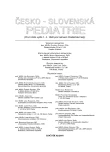Infection with Bacteria Pseudomonas aeruginosa in Patients with Cystic Fibrosis Diagnostics Possibilities and Clinical Outcomes of a Three-Year Study
Infekce bakteriemi Pseudomonas aeruginosa u nemocných cystickou fibrózou Možnosti diagnostiky a klinické výstupy tříleté studie
Cystická fibróza je závažné geneticky podmíněné onemocnění, které se v naší populaci vyskytuje v četnosti 1:2500–3500 živě narozených dětí. Toto multiorgánové onemocnění postihuje především respirační a zažívací trakt. Respirační postižení s účastí závažné infekce je hlavní příčinou progresivního respiračního selhání a předčasného úmrtí. Hlavními závažnými patogeny jsou bakterie Pseudomonas aeruginosa a bakterie komplexu Burkholderia cepacia. Včasná detekce této infekce pomáhá oddálit chronickou infekci a identifikace vysoce přenosných, epidemických kmenů přispívá k zavedení cílených protiepidemických opatření, která zabraňují přenosu infekce mezi pacienty a snižují incidenci nových infekcí. V diagnostice bakterií komplexu Burkholderia cepacia se mezníkem stalo zavedení přesné diagnostiky založené na metodě PCR. V diagnostice infekce Pseudomonas aeruginosa je význam této metody menší z důvodu menší přesnosti detekce. Pro včasnou detekci a léčbu infekce Pseudomonas aeruginosa klademe důraz na pravidelné kultivační vyšetření kombinované s PCR detekcí (ideálně v intervalech po 1 měsíci) a vyšetřením protilátek proti Pseudomonas aeruginosa.
Klíčová slova:
cystická fibróza, Pseudomonas aeruginosa, komplex Burkholderia cepacia, PCR diagnostika, protilátky proti Pseudomonas aeruginosa
Authors:
P. Pohunek; D. Zemková; J. Brázová; Š. Vošahlíková; V. Vávrová
Authors‘ workplace:
Pediatrická klinika UK 2. LF, FN Motol, Praha
přednosta prof. MUDr. J. Lebl, CSc.
Published in:
Čes-slov Pediat 2007; 62 (9): 527-533.
Category:
Original Papers
Overview
Cystic fibrosis is a serious genetically determined disease with the frequency of 1:
2500 to 3500 live born children in our population. This multi-organ disease affects especially respiratory and gastrointestinal tract. The respiratory defect with participation of a severe infection is the main cause of progressive respiratory failure and premature death. The main severe pathogens include Pseudomonas aeruginosa and bacteria of the Burkholderia cepacia complex. Early detection of this infection helps to postpone chronic infection and identification of highly communicable, epidemic strains helps to introduce targeted anti-epidemic measures, which prevent the transfer of infection among patients and decrease incidence of new infections. The introduction of precise diagnosis based on PCR methods became the landmark of diagnostics of the Burkholderia cepacia complex. The importance of this method is lower in the diagnostics of Pseudomonas aeruginosa infection due to a less precise detection. The authors draw attention to timely detection and therapy of intection by Pseudomonas aeruginosa based on regular cultures combined with PCR detection (optimally in monthly intervals) together with examination of anti Pseudomonas aeruginosa antibodies.
Key words:
cystic fibrosis, Pseudomonas aeruginosa, Burkholderia cepacia complex, PCR diagnostics, antibodies against Pseudomonas aeruginosa
Labels
Neonatology Paediatrics General practitioner for children and adolescentsArticle was published in
Czech-Slovak Pediatrics

2007 Issue 9
- What Effect Can Be Expected from Limosilactobacillus reuteri in Mucositis and Peri-Implantitis?
- The Importance of Limosilactobacillus reuteri in Administration to Diabetics with Gingivitis
Most read in this issue
- Infection with Bacteria Pseudomonas aeruginosa in Patients with Cystic Fibrosis Diagnostics Possibilities and Clinical Outcomes of a Three-Year Study
- Disorders of Hemostasis in Newborns
- Unstable Hemoglobin Variants in Children of the Czech and Slovak Population
- Program of Hematopoietic Stem Cell Transplantation in Children at Department of Pediatric Hematology and Oncology, University Hospital Motol – from Fetal Liver to Cord Blood
